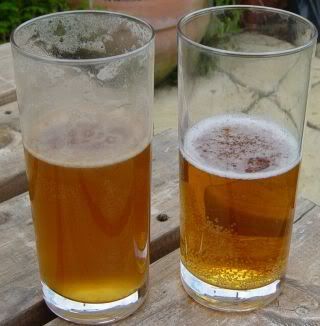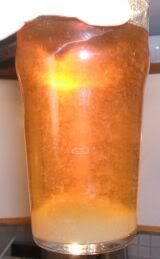homebrewer_99 said:
WTF!!!??? Why don't you just add the finings to the container they are already in???

You
can but mixing them in a little beer first helps them dispearese properly with minimum stirring. Proper issinglass is quite gelatinous and would otherwise need excessive stirring to distruibute properly and is best kept to a minimum in beer. It is actually very simple and commercial issinglass is amazing stuff.
I had a problem with a persistant yeast haze in a very pale (golden) ale which I wanted to serve in a few days so I added some directly to a corni keg. The intention was to get the finings to cause the yeast to drop out and then to draw off the yeast sediment. (Corni's draw from the bottom of the keg incase anyone reading doesn't know)
The glass on the left left is the first 1/3 pt drawn off from the keg with all the yeast and sediment the issinglass pulled out, on the right is next 1/3 of a pint drawn from the
same keg. The keg took about 3-4 hrs to fall bright.
This is a shot of issinglass in action (added directly to a glass of hazy beer), the yeast is floccing together and starting to drop out.
(btw, the on-line store I use for homebrew supplies sells this stuff for around £1 for 250mls so it's cheaper than most of the fancy brightly packged stuff available)
This was reasonably fresh issinglass, stored properly (less than 6 months old and kept chilled). The 2 year old dusty bottles kept on the shelf in the corner of the homebrew store wont have the same effect.
The best alternative I have found to issinglass is regular granulated gelatine.
To use, draw off 1 pt of beer into a pan, heat on the stove to 80 deg c (just don't allow to boil), sprinkle on the granules and keep stirring, do this for 5 mins or so stirring occasionally.
Remove from the heat and keep stirring occasionally while it cools (in a sink of cold water). Add to the secondary or keg once cool (it doesn't have to be stone cold) you can either rack on top of it or add it carefully directly to the beer in the secondary or the keg. The beer should fall bright in a day or two. If you don't keep stirring while preparing the gelatine will turn back into a harmless beer-jello and sit on the top of the beer in the secondary or keg and anoy you.
Gelatine forms a more stable sediment than issinglass.




